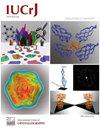Tuning structural modulation and magnetic properties in metal–organic coordination polymers [CH3NH3]CoxNi1−x(HCOO)3
IF 3.6
2区 材料科学
Q2 CHEMISTRY, MULTIDISCIPLINARY
引用次数: 0
Abstract
We show that the modulated phase transitions in solid solutions of [CH3NH3]CoxNi1−x(HCOO)3, with x = 0.25 (1), x = 0.50 (2) and x = 0.75 (3), can be tuned by the metal ratio, which offers the opportunity to consciously build molecular compounds with adjustable properties by doping metal sites.
Three solid solutions of [CH3NH3]CoxNi1−x(HCOO)3, with x = 0.25 (1), x = 0.50 (2) and x = 0.75 (3), were synthesized and their nuclear structures and magnetic properties were characterized using single-crystal neutron diffraction and magnetization measurements. At room temperature, all three compounds crystallize in the Pnma orthorhombic space group, akin to the cobalt and nickel end series members. On cooling, each compound undergoes a distinct series of structural transitions to modulated structures. Compound 1 exhibits a phase transition to a modulated structure analogous to the pure Ni compound [Cañadillas-Delgado, L., Mazzuca, L., Fabelo, O., Rodríguez-Carvajal, J. & Petricek, V. (2020). Inorg. Chem.59, 17896–17905], whereas compound 3 maintains the behaviour observed in the pure Co compound reported previously [Canadillas-Delgado, L., Mazzuca, L., Fabelo, O., Rodriguez-Velamazan, J. A. & Rodriguez-Carvajal, J. (2019). IUCrJ, 6, 105–115], although in both cases the temperatures at which the phase transitions occur differ slightly from the pure phases. Monochromatic neutron diffraction measurements showed that the structural evolution of 2 diverges from that of either parent compound, with competing hydrogen bond interactions that drive the modulation throughout the series, producing a unique sequence of phases. It involves two modulated phases below 96 (3) and 59 (3) K, with different q vectors, similar to the pure Co compound (with modulated phases below 128 and 96 K); however, it maintains the modulated phase below magnetic order [at 22.5 (7) K], resembling the pure Ni compound (which presents magnetic order below 34 K), resulting in an improper modulated magnetic structure. Despite these large-scale structural changes, magnetometry data reveal that the bulk magnetic properties of these solid solutions form a linear continuum between the end members. Notably, doping of the metal site in these solid solutions allows for tuning of bulk magnetic properties, including magnetic ordering temperature, transition temperatures and the nature of nuclear phase transitions, through adjustment of metal ratios.
调谐金属有机配位聚合物 [CH3NH3]CoxNi1-x(HCOO)3 的结构调制和磁性能。
我们合成了三种 [CH3NH3]CoxNi1-x(HCOO)3 固溶体(x = 0.25 (1)、x = 0.50 (2) 和 x = 0.75 (3)),并利用单晶中子衍射和磁化测量对它们的核结构和磁性能进行了表征。在室温下,这三种化合物都在 Pnma 正交空间群中结晶,类似于钴和镍端系列成员。冷却时,每种化合物都会经历一系列不同的结构转变,形成调制结构。化合物 1 显示了向类似于纯镍化合物的调制结构的相变[Cañadillas-Delgado, L., Mazzuca, L., Fabelo, O., Rodríguez-Carvajal, J. & Petricek, V. (2020)。Inorg.Chem.59,17896-17905],而化合物 3 保持了之前报告的纯 Co 化合物中观察到的行为[Canadillas-Delgado,L.,Mazzuca,L.,Fabelo,O.,Rodriguez-Velamazan,J. A. & Rodriguez-Carvajal, J. (2019)。IUCrJ, 6, 105-115],尽管在这两种情况下发生相变的温度与纯相略有不同。单色中子衍射测量结果表明,2 的结构演化与母体化合物的结构演化不同,竞争性氢键相互作用推动了整个系列的调制,产生了独特的相序列。它在 96 (3) K 和 59 (3) K 以下涉及两个调制相,具有不同的 q 向量,与纯 Co 化合物类似(在 128 K 和 96 K 以下具有调制相);然而,它在磁序[22.5 (7) K]以下保持调制相,与纯 Ni 化合物类似(在 34 K 以下呈现磁序),从而产生了不恰当的调制磁结构。尽管存在这些大规模的结构变化,但磁力测量数据显示,这些固溶体的体磁性能在末端成员之间形成了一个线性连续体。值得注意的是,在这些固溶体中掺杂金属位点可以通过调整金属比例来调整体磁特性,包括磁有序温度、转变温度和核相变的性质。
本文章由计算机程序翻译,如有差异,请以英文原文为准。
求助全文
约1分钟内获得全文
求助全文
来源期刊

IUCrJ
CHEMISTRY, MULTIDISCIPLINARYCRYSTALLOGRAPH-CRYSTALLOGRAPHY
CiteScore
7.50
自引率
5.10%
发文量
95
审稿时长
10 weeks
期刊介绍:
IUCrJ is a new fully open-access peer-reviewed journal from the International Union of Crystallography (IUCr).
The journal will publish high-profile articles on all aspects of the sciences and technologies supported by the IUCr via its commissions, including emerging fields where structural results underpin the science reported in the article. Our aim is to make IUCrJ the natural home for high-quality structural science results. Chemists, biologists, physicists and material scientists will be actively encouraged to report their structural studies in IUCrJ.
 求助内容:
求助内容: 应助结果提醒方式:
应助结果提醒方式:


